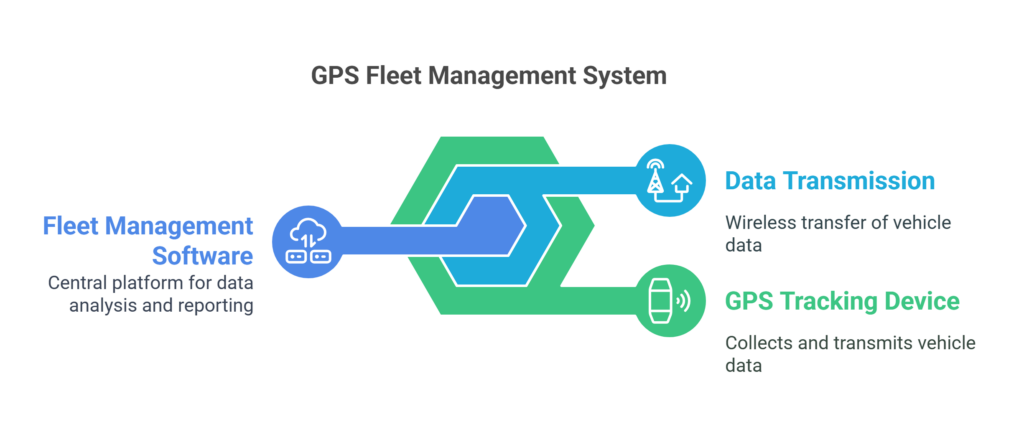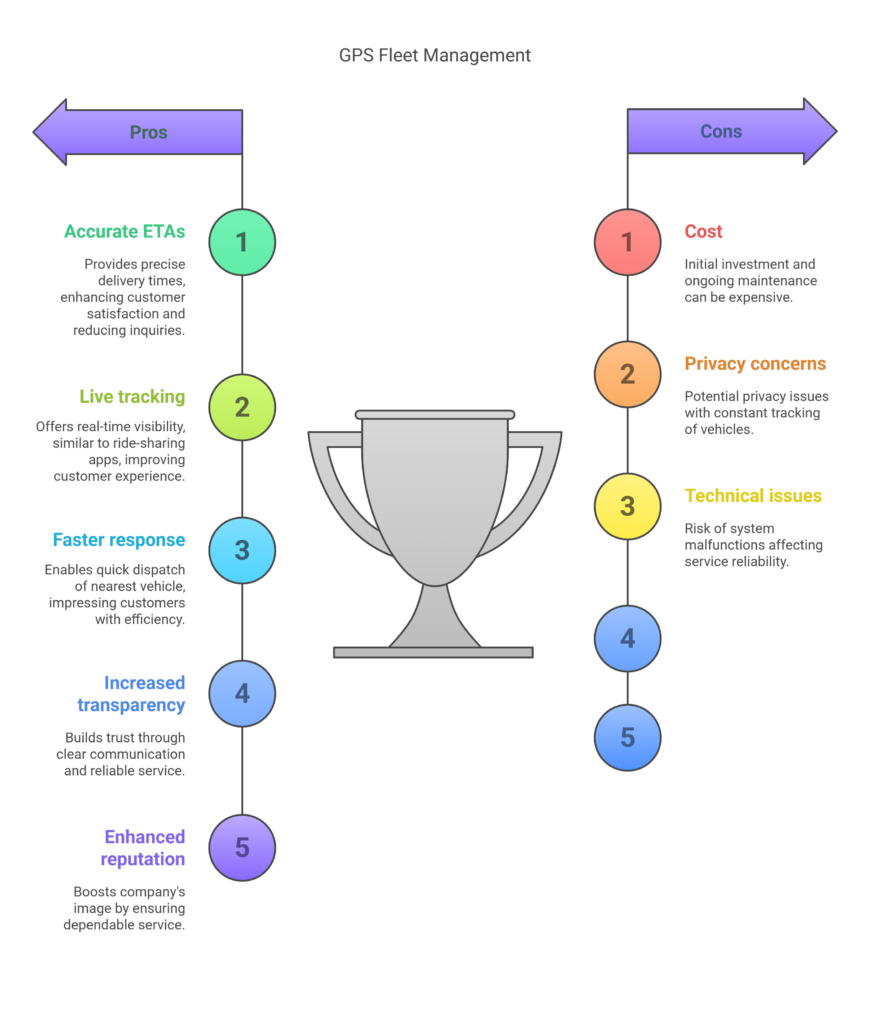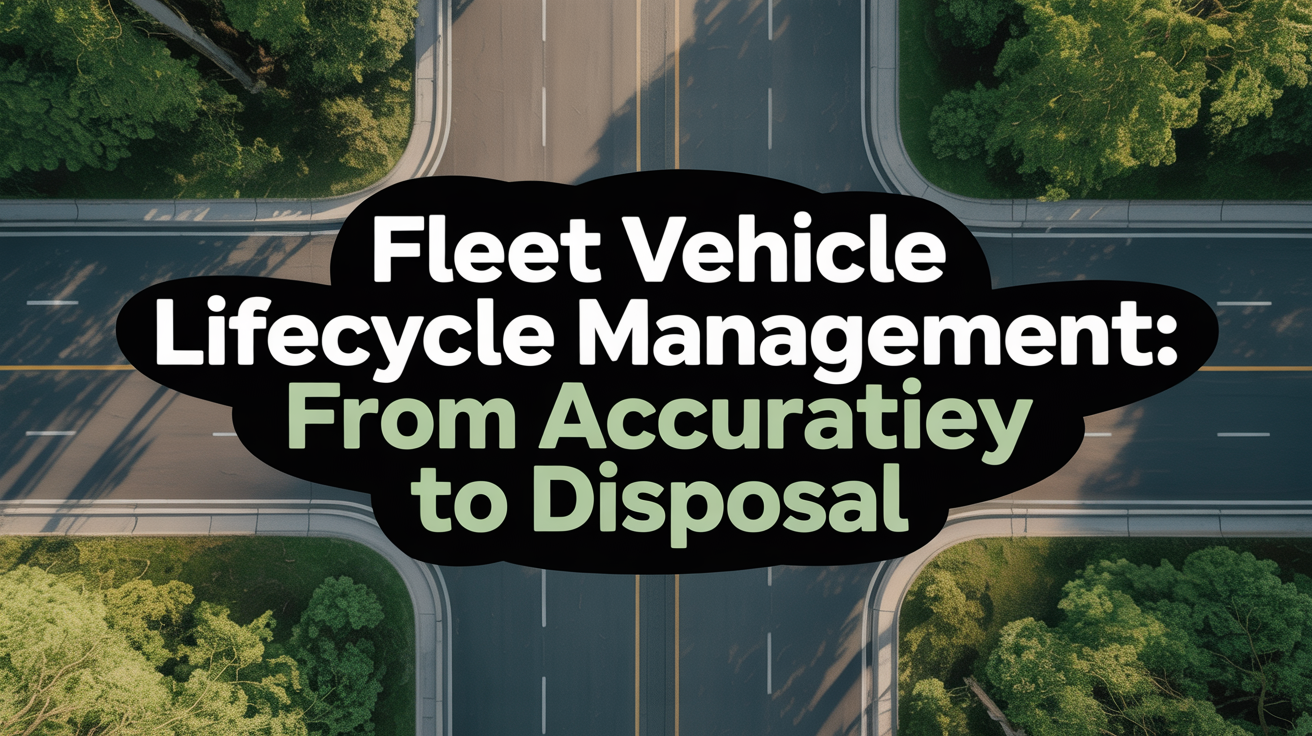Introduction
Skyrocketing fuel costs and rising customer expectations are putting a squeeze on margins for fleet operators—yet many fleets still operate without the real-time data that could save thousands. Are you unknowingly letting inefficiency drain your profits? GPS fleet management gives you the power to cut waste, boost safety, and sharpen your operational edge.
You’ll walk away understanding:
- How tracking and telematics directly affect your costs, safety protocols, and service quality.
- Which features distinguish the best GPS fleet platforms from basic tracking systems.
- How a partner like Nektar can transform your fleet with actionable insights—not just a flood of data.
Forget relying on guesswork—what you need to grasp right now is that modern GPS fleet management turns every mile driven and every driver action into an opportunity for improvement and profit. This piece answers the critical questions and reveals what top-tier platforms deliver.
What Is GPS Fleet Management?
At its core, GPS fleet management is about using technology to gain visibility and control over your mobile assets – your vehicles, drivers, and sometimes even equipment. It combines Global Positioning System (GPS) technology for location tracking with telematics systems that collect a wider range of vehicle data (like speed, engine status, fuel consumption). This information streams in real-time to a central software platform, usually accessible via web or mobile app.
The main goal? Optimization. Businesses use these systems to make smarter decisions about routing, dispatching, maintenance, and driver behavior. Think of it as the central nervous system for your fleet operations, connecting managers to what’s happening on the ground, moment by moment. It’s fundamental for boosting productivity, ensuring driver safety, managing fuel expenses, and keeping maintenance on schedule. It transforms guesswork into data-backed strategy. 🗺️
“GPS fleet tracking uses telematics technology to collect data from fleet vehicles and assets. A GPS tracking device is attached to a fleet vehicle, allowing it to accurately determine the vehicle’s position.” – eFleets source
Key Benefits of GPS Fleet Management
Adopting a robust GPS fleet management system brings a wave of advantages that ripple across your entire operation. One of the most immediate impacts is on operational efficiency. Imagine optimizing routes automatically to cut down mileage, avoid traffic jams, and fit more jobs into the day. Dispatchers can see exactly where vehicles are and assign the closest driver to a new service call, slashing response times.
Beyond efficiency, the cost savings are substantial. Less mileage directly translates to lower fuel consumption – often a fleet’s biggest variable expense. Monitoring driver behavior like speeding, harsh braking, and excessive idling also curbs fuel waste and reduces wear and tear on vehicles, leading to lower maintenance costs. Plus, proving safer driving habits can potentially lower insurance premiums. 💰
Safety gets a major boost too. Real-time alerts can notify managers of unsafe driving actions instantly, allowing for prompt intervention or coaching. Tracking helps locate vehicles quickly in emergencies and can aid in recovering stolen assets. Better route planning avoids dangerous areas or conditions. All this contributes not only to driver well-being but also enhances your company’s reputation and reduces liability risks. And let’s not forget happier customers, who benefit from more accurate ETAs and reliable service. 👍
“GPS tracking systems provide an array of benefits including enhancing the efficiency of the fleet, increasing productivity, better asset management, and more.” – TrackOBit source
How GPS Fleet Management Works
It might sound complex, but the process is quite straightforward. First, a small GPS tracking device, often called a telematics unit, is installed in each vehicle. This device contains a GPS receiver to pinpoint its location and often other sensors to collect data like speed, acceleration, engine diagnostics (via the OBD-II port), and more. It uses a cellular or satellite network to transmit this data wirelessly.
This data flows constantly to a secure cloud-based platform – the software heart of the system. Here, the raw data is processed, analyzed, and presented to fleet managers through user-friendly dashboards, maps, and reports. Managers can log in from their computer or smartphone to see live vehicle locations, review trip histories, analyze driving patterns, set up alerts for specific events (like entering a restricted zone or speeding), and generate reports on fuel usage, maintenance needs, and overall fleet performance. 💻📱

“Fleet tracking and telematics is a management system that uses GPS tracking for fleets to monitor the activity of fleet vehicles, employees and equipment.” – eFleets source
Essential Features to Look For
When evaluating GPS fleet management platforms, certain features are non-negotiable for getting real value. Real-time location tracking is the foundation – knowing where your vehicles are *right now* is crucial for dispatching, security, and customer updates. Look for systems with high accuracy and frequent updates. Closely related are alerts and notifications; you need the system to proactively tell you about important events like speeding, geofence breaches (entering or leaving predefined areas), or excessive idling, rather than needing to constantly watch the map.
Route optimization is another powerhouse feature. Good systems don’t just show you where vehicles *went*, they help plan the *best* way to go, considering traffic, stop duration, vehicle type, and other constraints. Fuel monitoring is also critical, identifying wastage from idling or inefficient driving, and potentially detecting fuel theft. Look for detailed reports that track fuel consumption per vehicle or trip. Driver behavior monitoring, tracking actions like harsh braking, rapid acceleration, and speeding, is essential for safety coaching and reducing wear-and-tear. 📊
Finally, consider integration capabilities. Can the platform connect with your existing fuel card programs, maintenance logs, dispatch software, or accounting systems? Seamless integration avoids duplicate data entry and provides a more holistic view of your operations. Geofencing allows you to create virtual boundaries and get alerts when vehicles cross them – great for confirming site visits or preventing unauthorized use. The right mix of features depends on your specific needs, whether you run a small delivery service or a large construction fleet.
“A GPS tracking device is one of the most important features to look for in a fleet management system. Once installed in your fleet’s vehicle, the device can send real-time location and movement updates.” – MiX Telematics source
Cost Savings and ROI
Let’s talk dollars and cents. GPS fleet management isn’t just a fancy tech gadget; it’s an investment designed to pay for itself, often quite quickly. The most significant savings usually come from fuel reduction. Optimized routes mean fewer miles driven, and monitoring driving habits curbs fuel-wasting behaviors like speeding and idling. Many companies report fuel cost reductions of 10-20% or even more. ⛽️⬇️
Maintenance costs also drop. Reduced mileage and gentler driving lessen vehicle wear. Proactive maintenance alerts based on actual usage (not just arbitrary schedules) prevent minor issues from becoming major, costly repairs. Improved efficiency means better labor utilization – drivers complete more jobs in the same amount of time. Insurance costs can potentially decrease as well, as many insurers offer discounts for fleets demonstrating improved safety through telematics. When you add up savings across fuel, maintenance, labor, and potentially insurance, the return on investment (ROI) for GPS fleet management can be remarkably fast, sometimes within just a few months.
“Using GPS fleet tracking helps reduce costs associated with inefficient routing, fuel waste, and vehicle maintenance.” – Ezlogz source
Fleet Safety and Compliance
Keeping drivers safe and operations compliant is paramount. GPS fleet management provides powerful tools to achieve both. By monitoring driving behavior – speed, braking force, acceleration, cornering – managers get objective data to identify risky habits. Automated alerts can flag dangerous incidents in real-time, allowing for immediate feedback or intervention. This data forms the basis for targeted driver coaching programs, reinforcing safe practices and reducing accident rates. 🛡️
Compliance with regulations, such as Hours of Service (HOS) rules for commercial drivers, becomes much simpler. Electronic Logging Devices (ELDs), often integrated into GPS fleet platforms, automate log keeping, ensuring accuracy and reducing the administrative burden. Digital Vehicle Inspection Reports (DVIRs) can also be handled through the system, streamlining pre-trip and post-trip checks and keeping maintenance records organized. This digital documentation makes audits smoother and helps avoid hefty fines for non-compliance.
“Another advantage of GPS trackers that benefits fleets is alerting managers and drivers about poor driving behaviors like harsh acceleration, braking, cornering, and speeding events.” – MiX Telematics source
Customer Service Improvements
Happy customers are repeat customers, and GPS fleet management directly contributes to a better customer experience. Real-time tracking means you can provide much more accurate Estimated Times of Arrival (ETAs). No more vague delivery windows! You can tell customers precisely when to expect their service or delivery, increasing their satisfaction and reducing inbound “where’s my driver?” calls. 🚚💨
Some systems even allow you to share a live tracking link with customers, giving them visibility as the vehicle approaches – think ride-sharing app convenience for your business. Faster response times, enabled by dispatching the nearest available vehicle, also impress customers. Overall, the increased transparency, reliability, and communication facilitated by GPS tracking build trust and enhance your company’s reputation for dependable service. 😊

“Customers today expect fast, reliable service, and fleet vehicle gps tracking helps meet those expectations.” – Ezlogz source
Reducing Operational Risks and Theft
Your vehicles and the equipment they carry are valuable assets. GPS fleet management acts as a powerful deterrent against theft and misuse. The mere presence of tracking devices can discourage unauthorized use or outright theft. Should a vehicle be stolen, real-time tracking dramatically increases the chances of quick recovery by providing law enforcement with its exact location. 📍🚓
Geofencing adds another layer of security. You can set up virtual boundaries around yards, job sites, or approved routes. If a vehicle enters or leaves a geofenced area outside of authorized hours, an instant alert is sent to management. This helps prevent vehicles from being taken off-site without permission and provides immediate notification if assets stray. In emergencies, knowing the precise location of a vehicle can also speed up response times for roadside assistance or medical help.
“Since fleet monitoring offers real-time visibility into the status of the vehicle, it will be easy to recover from any theft of vehicles or equipment as you can immediately inform the concerned authority.” – Rentall Software source
The Role of Data and Analytics
GPS fleet management platforms collect a vast amount of data, but the real magic happens when that data is turned into actionable insights. It’s not just about seeing dots on a map; it’s about understanding trends, identifying inefficiencies, and making smarter strategic decisions. Good platforms offer robust reporting and analytics tools that distill complex information into easy-to-understand charts and summaries. 📈
You can analyze historical trip data to refine routes over time, compare fuel efficiency across different vehicle models or drivers, identify patterns in driver behavior that need addressing, or forecast maintenance needs based on actual mileage and engine diagnostics. This data-driven approach helps optimize everything from driver schedules to vehicle replacement cycles. Instead of reacting to problems, you can proactively manage your fleet for peak performance and profitability.
“Provide insights for the creation of smarter fleet management strategies based on real-time data provided by GPS tracking systems.” – Cprime source
Customization and Integration Capabilities
No two fleets are exactly alike, so flexibility is key. Look for GPS fleet management platforms that can be customized to your specific industry and operational needs. This might involve setting up custom alerts, creating industry-specific report templates, or tracking unique data points relevant to your business (like temperature monitoring for refrigerated trucks).
Equally important is the ability to integrate with other software systems you already use. Connecting your fleet management platform with fuel card data provides a complete picture of fuel spending and efficiency. Integration with maintenance software can automate work order creation based on diagnostic trouble codes. Linking with payroll or billing systems can streamline administrative tasks based on trip data. A system that works well with your existing tools creates a more unified and efficient operational workflow. Check for compatibility with mobile apps for drivers and managers, ensuring access on the go. 🔗
“Fleet management systems are viewed as tools for operational control and fleet management…These systems are flexible, adaptable and can be integrated with applications that already exist in the organisation and information can be used in real time.” – UKZN source
Why Nektar for GPS Fleet Management?
Choosing the right partner is crucial, and this is where Nektar stands out. Nektar goes beyond basic tracking, offering a sophisticated platform focused on turning data into tangible results. Their user-friendly dashboards make complex information accessible, allowing fleet managers to quickly spot trends, identify issues, and make informed decisions without getting lost in spreadsheets. They understand the common pain points – fuel costs, safety concerns, compliance headaches – and have built their platform to directly address them.
What really sets Nektar apart is their commitment to advanced analytics and actionable insights. They don’t just show you data; they help you understand what it means for your business and how to use it to improve. With features designed for efficiency, safety, and cost reduction, coupled with responsive customer support, Nektar helps clients achieve a strong return on investment quickly. If you’re looking for a GPS fleet management partner that delivers real value and helps you stay ahead, Nektar is worth serious consideration. ✨

Frequently Asked Questions (FAQ)
- How does GPS fleet management improve operational efficiency?
It boosts efficiency by providing real-time vehicle locations for smarter dispatching, optimizing routes to cut mileage and save time, monitoring driver productivity, automating tasks like logging and reporting, and enabling proactive maintenance scheduling. This minimizes wasted fuel, reduces downtime, and allows you to fit more work into each day. - What types of businesses benefit most from GPS fleet management?
Virtually any business with a fleet of vehicles can benefit! It’s particularly valuable for industries like delivery and courier services, logistics and trucking, field services (HVAC, plumbing, electrical), construction, passenger transport (taxis, buses), waste management, and government fleets. Both small fleets and large enterprises see significant gains. - How secure is my fleet data with GPS tracking platforms?
Reputable providers like Nektar prioritize data security. Data is typically transmitted wirelessly using encryption, stored securely in cloud data centers with robust physical and digital security measures, and accessed through password-protected accounts with defined user permissions. Look for providers who follow industry best practices for data privacy and security. 🔒 - Can GPS fleet management help reduce insurance premiums?
Yes, it potentially can. By monitoring and improving driver safety (reducing speeding, harsh braking), deterring theft with real-time tracking, and ensuring compliance, you lower your fleet’s overall risk profile. Many insurance companies recognize this and may offer discounts or better rates to fleets using telematics systems. - What is required to implement GPS fleet management in my company?
Implementation typically involves a few key steps. First, GPS tracking devices need to be installed in each vehicle (this can often be done quickly and easily). Then, you’ll set up your account on the software platform, configuring users, vehicles, and any custom alerts or geofences. Finally, some basic training for managers and drivers on how to use the system ensures everyone gets the most value from day one. Providers like Nektar often offer support throughout this onboarding process.
Conclusion
Running a modern fleet based on intuition just doesn’t cut it anymore. GPS fleet management platforms, especially comprehensive ones like those offered by Nektar, provide the essential visibility, control, and data-driven intelligence needed to dramatically reduce costs, elevate safety standards, delight customers, and drive continuous improvement. The leading platforms don’t just track vehicles; they actively convert data into measurable business results that foster growth.
Ready to gain control and unlock your fleet’s potential? Visit Nektar today to see how the right GPS fleet management approach can put you miles ahead of the competition. 🏆
Key Takeaways:
- GPS fleet management revolutionizes operational efficiency, safety culture, and cost structures through real-time data insights and automation.
- Indispensable features include live tracking, intelligent route optimization, driver behavior analysis, fuel monitoring, and seamless integration with other business tools.
- Platforms like Nektar deliver clear ROI by enabling proactive management, minimizing operational risks, and improving the customer service experience.



